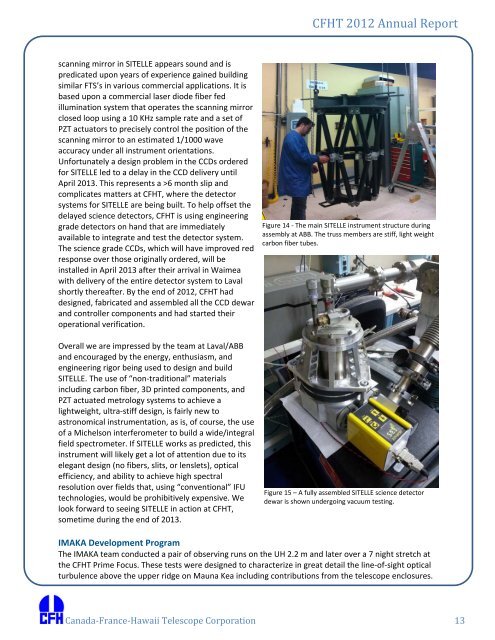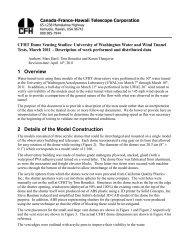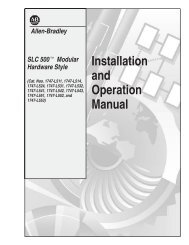2012 CFHT Annual Report - Canada France Hawaii Telescope ...
2012 CFHT Annual Report - Canada France Hawaii Telescope ...
2012 CFHT Annual Report - Canada France Hawaii Telescope ...
You also want an ePaper? Increase the reach of your titles
YUMPU automatically turns print PDFs into web optimized ePapers that Google loves.
<strong>CFHT</strong> <strong>2012</strong> <strong>Annual</strong> <strong>Report</strong><br />
scanning mirror in SITELLE appears sound and is<br />
predicated upon years of experience gained building<br />
similar FTS’s in various commercial applications. It is<br />
based upon a commercial laser diode fiber fed<br />
illumination system that operates the scanning mirror<br />
closed loop using a 10 KHz sample rate and a set of<br />
PZT actuators to precisely control the position of the<br />
scanning mirror to an estimated 1/1000 wave<br />
accuracy under all instrument orientations.<br />
Unfortunately a design problem in the CCDs ordered<br />
for SITELLE led to a delay in the CCD delivery until<br />
April 2013. This represents a >6 month slip and<br />
complicates matters at <strong>CFHT</strong>, where the detector<br />
systems for SITELLE are being built. To help offset the<br />
delayed science detectors, <strong>CFHT</strong> is using engineering<br />
grade detectors on hand that are immediately<br />
available to integrate and test the detector system.<br />
The science grade CCDs, which will have improved red<br />
response over those originally ordered, will be<br />
installed in April 2013 after their arrival in Waimea<br />
with delivery of the entire detector system to Laval<br />
shortly thereafter. By the end of <strong>2012</strong>, <strong>CFHT</strong> had<br />
designed, fabricated and assembled all the CCD dewar<br />
and controller components and had started their<br />
operational verification.<br />
Overall we are impressed by the team at Laval/ABB<br />
and encouraged by the energy, enthusiasm, and<br />
engineering rigor being used to design and build<br />
SITELLE. The use of “non‐traditional” materials<br />
including carbon fiber, 3D printed components, and<br />
PZT actuated metrology systems to achieve a<br />
lightweight, ultra‐stiff design, is fairly new to<br />
astronomical instrumentation, as is, of course, the use<br />
of a Michelson interferometer to build a wide/integral<br />
field spectrometer. If SITELLE works as predicted, this<br />
instrument will likely get a lot of attention due to its<br />
elegant design (no fibers, slits, or lenslets), optical<br />
efficiency, and ability to achieve high spectral<br />
resolution over fields that, using “conventional” IFU<br />
technologies, would be prohibitively expensive. We<br />
look forward to seeing SITELLE in action at <strong>CFHT</strong>,<br />
sometime during the end of 2013.<br />
Figure 14 ‐ The main SITELLE instrument structure during<br />
assembly at ABB. The truss members are stiff, light weight<br />
carbon fiber tubes.<br />
Figure 15 – A fully assembled SITELLE science detector<br />
dewar is shown undergoing vacuum testing.<br />
IMAKA Development Program<br />
The IMAKA team conducted a pair of observing runs on the UH 2.2 m and later over a 7 night stretch at<br />
the <strong>CFHT</strong> Prime Focus. These tests were designed to characterize in great detail the line‐of‐sight optical<br />
turbulence above the upper ridge on Mauna Kea including contributions from the telescope enclosures.<br />
<strong>Canada</strong>‐<strong>France</strong>‐<strong>Hawaii</strong> <strong>Telescope</strong> Corporation 13




![Documentation [PDF] - Canada France Hawaii Telescope ...](https://img.yumpu.com/26965302/1/190x245/documentation-pdf-canada-france-hawaii-telescope-.jpg?quality=85)







